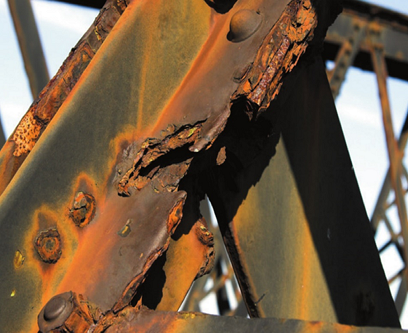Corrosion protection knowledge
- Categories:Coating Q&A
- Author:
- Origin:
- Time of issue:2021-06-07
- Views:0
(Summary description)What is metal corrosion?
Metal corrosion is a phenomenon in which metal and surrounding media undergo chemical, electrochemical, or physical interaction to become a metal compound and be destroyed.
Corrosion protection knowledge
(Summary description)What is metal corrosion?
Metal corrosion is a phenomenon in which metal and surrounding media undergo chemical, electrochemical, or physical interaction to become a metal compound and be destroyed.
- Categories:Coating Q&A
- Author:
- Origin:
- Time of issue:2021-06-07
- Views:0
1. What is metal corrosion?
Metal corrosion is a phenomenon in which metals and surrounding media undergo chemical, electrochemical or physical interactions to become metal compounds and are damaged;
2. What kinds of common corrosions of metal pipes can be divided into according to their principle of action?
The common corrosion of metal pipelines can be divided into chemical corrosion and electrochemical corrosion according to its principle of action.
3. What are the commonly used anti-corrosion measures?
Commonly used anti-corrosion measures include coatings, linings, electrical protection and corrosion inhibitors.
4. What is electrochemical corrosion?
Electrochemical corrosion refers to the phenomenon of destruction of metal and electrolyte due to electrochemical reaction.
5. How does crevice corrosion occur?
Many metal components are connected by screws, riveting, welding, etc., and narrow gaps may appear at the defects of these connectors or welded joints. The width of the gap (usually 0.025~0.1mm) is sufficient to allow the electrolyte solution to enter and make the gap The metal and the metal outside the seam form a short-circuit galvanic cell, and strong corrosion occurs in the seam. This localized corrosion is called crevice corrosion.
6. What is pitting corrosion?
Pitting corrosion refers to the form of pore-like corrosion in which corrosion is concentrated in a local area of the metal surface and penetrates deep into the metal.
7. What are the characteristics of pitting corrosion and pitting corrosion?
Pitting corrosion: the diameter of the pit hole is smaller than the depth; pitting corrosion: the diameter of the pit hole is greater than the depth.
8. What is stress corrosion, and stress corrosion can be divided into several types according to the corrosion mechanism?
The material destruction process caused by the combined effect of strain and corrosion caused by residual or applied tensile stress is called stress corrosion. According to the corrosion mechanism, stress corrosion can be divided into: (1) anodic dissolution (2) hydrogen-induced cracking.
9. What is the definition of corrosion fatigue?
Under the synergistic effect of alternating stress and metal in a corrosive environment, the destruction of materials is called corrosion fatigue.
10. How does oxygen concentration corrosion occur?
The most common corrosion phenomenon in underground pipelines is the oxygen concentration difference battery. Because the oxygen concentration is different in different parts of the pipeline, the natural potential (non-equilibrium potential) of the pipeline at the oxygen-poor part is low, which is the anode of the corrosive galvanic cell. Its anodic dissolution rate is significantly higher than the anodic dissolution rate of the rest of the surface, so it suffers from corrosion. . When the pipeline passes through the junction of different types of soil, the clay section is depleted in oxygen and is prone to corrosion, especially at the junction of two soils or the part of the buried pipeline near the excavation end. For oil storage tanks, the oxygen concentration difference is mainly manifested in the poor contact between the bottom of the tank and the sand base, and the difference in air permeability between the tank circumference and the center of the tank. The oxygen concentration in the center is low, which becomes the anode and is corroded.
11. What is bacterial corrosion? How is it produced?
Bacterial corrosion is a phenomenon in which when metals are corroded in soil containing sulfates, the cathodic reaction hydrogen reduces sulfates to sulfides, and sulfate-reducing bacteria use the energy of the reaction to multiply to accelerate metal corrosion. When sulfate is contained in some hypoxic soils, sulfate-reducing bacteria will multiply. They need hydrogen or some reducing substances in the metabolic process to reduce sulfate to sulfide and use the energy of the reaction to multiply. SO42-+ 8H→S2-+4H2O Due to the presence of sulfate and other H+, the cathodic reaction of metal corrosion in the soil produces atomic hydrogen. In the soil, it attaches to the metal surface, and cannot continuously escape as bubbles, and cathodic polarization will occur, which significantly slows down the corrosion process. However, the presence of bacteria in sulfuric acid happened to find a way out for atomic hydrogen, reducing SO42- to S2-, and then combining with Fe2+ to form a black FeS deposit. When the soil pH is 5-9 and the temperature is 25-30℃, it is most conducive to the reproduction of bacteria.
12. How does galvanic corrosion occur?
When two metals or alloys with different electrode potentials are in contact with each other and are in the electrolyte solution, the metal with the more negative electrode potential is constantly corroded, while the metal with the positive electrode potential is protected. This kind of corrosion is called galvanic corrosion.
Scan the QR code to read on your phone
推荐新闻
Wuxi Huadong Zindn Science And Technology Co.,Ltd.
Headquarters contact number:
Free hotline:
86 4006083698
E-mail:
Add:
9th Floor of Wei chuang Building, No.999 Gaolang East Road,Wuxi, Jiangsu, China
Copyright © 2021 Wuxi Huadong Zindn Technology Co., LTD 京ICP证000000号


 frankie@zindn.com
frankie@zindn.com +86 18626194558
+86 18626194558 Online message
Online message 

